Kinds of Palm Trees Florida Climates Support
The kinds of palm trees Florida climates support may be familiar or surprise you. Yet we all know that Palms in Florida are fully associated with the state.
- First let's look at native palm trees in Florida which are naturally suited to the climate.
- Then we'll see which palms, although not native, do well in Florida.
- And we'll include tips, problems, and controversies about different kinds of palm trees in Florida.
- Click below to jump to some of the most popular kinds of palm trees Florida grows.
Or use our category TOC below to see the full list that includes what you should know.
Native Palm Trees in Florida
The twelve palm species below are endemic to Florida. Florida's native palm species typically tolerate - even prefer - the alkalotic soils found in the state.
Sadly half of these natives are either endangered or threatened in the state.
Cabbage Palm
Sabal palmetto is Florida's state tree, often just called the Palmetto.
- Ends up somewhere within 60-80ft/18-24m tall.
- Zone 7b is doable in warmest areas, without the coldest winters. But 8-11 is best.
- Gorgeous round crown full of palmate (fan) fronds.
- WEAKNESS PRECAUTIONS:
- Watch out for ganoderma and graphiola false smut.
- Has been known to get lethal bronzing.
- Pests: palmetto weevils and leaf hoppers
You can speed up its slow growth a bit by adding some humus content & regular watering.
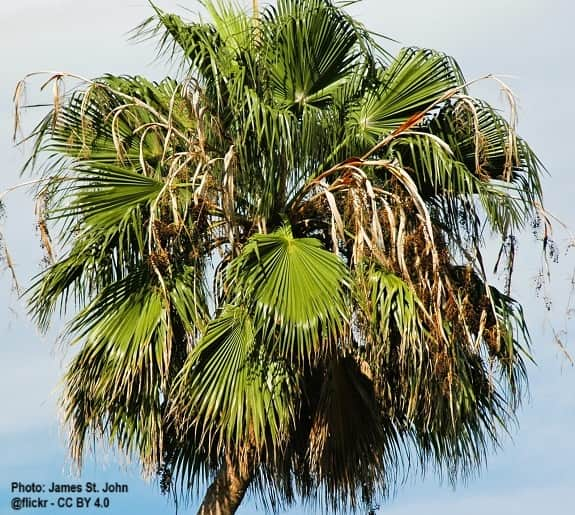 Here you can see the full round crown.
Here you can see the full round crown.Saw Palmetto
Serenoa repens is native to Florida's scrublands, sand dunes (does fine with salty soil) and piney woods.
- Trunks are subterranean. Then rise with clusters at ground level.
- The fan/palmate fronds grow thickly along the trunk.
- It's usually hardy. Good for zones 8-11, even 7 with Palm Cold Protection.
- WEAKNESS PRECAUTIONS:
- Ganoderma disease
- Palmetto weevil pests
It's excellent ground cover can be useful in Landscaping Plans. But check with you HOA, as many ban it.
 Spreading trunk has begun to show.
Spreading trunk has begun to show.Needle Palm
Rhapidophyllum hystrix has multiple common names including Creeping Palmetto & Hedgehog Palm.
- One of the most cold-hardy palms. It's suitable for Zones 6-10. Possibly even 5!
- Maxing out at 12ft/3.7m.
- The stunning palmate fronds have nice green segments.
It's ideal for shadier spots in your landscape, as it doesn't need full sun all day long.
The main disease worry is lethal bronzing.
 The Needle Palm
The Needle PalmRoyal Palm
Roystonea regia is limited to South Florida: Collier, Monroe & Dade counties. Some say it's the most beautiful palm, maybe why it's now endangered.
- One of the Very Tall Palms, it can reach 100ft/30.5m.
- The epithet, regia, means regal. As it does bring a regal touch to landscapes with room for growing it.
- Adding to that noble appearance, it has a 6ft/1.8m emerald green Crownshaft below its feathery, round crown.
Although it needs warmth & regular water, it's known to survive cold snaps & drought. It protects itself by sinking in areas of the trunk.
 The Royal Palm aka Cuban Royal Palm
The Royal Palm aka Cuban Royal PalmWatch out for potassium (K), manganese (Mn), or boron (B) Palm Problems. Palms need these Essential Nutrients. Yet an imbalance can happen if your Royal is growing in native soils with limestone deposits making a high pH.
Also watch for signs of Royal Palm Bug pests, fungal leaf spots, ganoderma and phytophthora bud rot.
Dwarf Palmetto
Sabal minor is among the most cold-tolerant palms.
- Zones 6-11 fit it well, even 5 has been done.
- Also called Swamp Palmetto, as it loves water. And prefers some shade.
- Trunk height varies from 8-18ft/2.4-5.5m, depending on form. As they can grow underground, along the ground, or upright.
- One precaution: susceptible to graphiola false smut.
One important Palm Identification aid is noting its Costapalmate Fronds.
 Note the green streak entering the frond from the petiole - that's the costa.
Note the green streak entering the frond from the petiole - that's the costa.Silver Palm
Coccothrinax argentata is often known as Hispaniola Silver Thatch Palm, as it's endemic there, too. But it's considered threatened in Florida.
- Usually gets to 20ft/6m tall.
- The trunk appears matted with dark fibers.
- Fully round palmate fronds are satiny green above.
- This drought tolerant palm is subject to Phytophthora bud rot With Overwatering. And prevention for graphiola false smut.
Its named for the noticeably silvery tinge underneath. Reminding some of a starburst look.
Keys Thatch Palm
Leucothrinax morrisii is a short palm fellow, getting slowly to only 36ft/11m. Suitable for Zone 9b and warmer. You may still find it listed under the old name: Thrinax morrisii.
- The trunk is nice and smooth, with brown or gray coloring.
- The palmate leaves are typically pale green, with whitish undersides. Making a nice round crown.
- A helpful identification mark is the hastula (See Palm Frond Parts>)
It goes by several other nicknames: Brittle Thatch, Buffalo Thatch & Silvertop-palmetto. It's named as among the kinds of palm trees Florida lists as threatened.

Sargent's Cherry Palm
Pseudophoenix sargentii loves a sandy beach, or scrubby sandy areas. And it's easy to grow.
- The solitary trunk can reach 25ft/8m tall, topped with approximately 12 feathery pinnate fronds.
- It's not much bothered by salty sea spray, and it likes alkaline soils, unlike most palms.
- Suitable for Zone 9b, as it won't easily tolerate temps down to 28oF/-2oC.
People loving its growing ease and bright red fruit have taken them from the wild. Giving it a threatened status. Not helpful is a weakness for lethal bronzing.
 Gorgeous, aka the Buccaneer Palm
Gorgeous, aka the Buccaneer PalmFlorida Thatch Palm
Thrinax radiata is another slow grower. With palmate leaves, it still holds its own in strong winds. Yet it's listed as endangered in Florida.
- It can achieve 30ft/9m in the best conditions.
- It can be grown in 10a+ hardiness zones. Yet can tolerate temporary temps as low as 29oF/1.7oC.
- It's long-lived, as some have been estimated at 150 years old!
 You'll see it along major roadways in South Florida, as well as individuals' landscaped yards.
You'll see it along major roadways in South Florida, as well as individuals' landscaped yards.Scrub Palmetto
Sabal etonia likes growing underneath the crowns of scrub pines.
- It's a shrubby short palm, as its trunk stays mostly underground. So it only grows to 4ft/1.2m, and just a bit wider.
- The leaves are costapalmate. Which is a good ID aid.
- One scrubby palm that doesn't want any saltiness to the soil.
It's a Florida palm that can do a bit better with cooler areas. It's best for zone 8b and up.
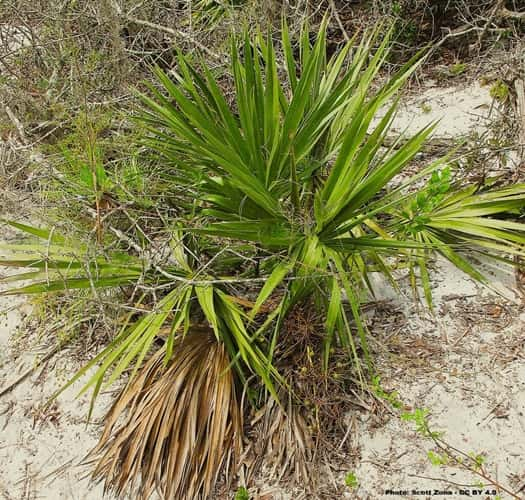
Florida Palm Natives Cheat Sheet
Patti J. Anderson, Ph.D., from the Bureau of Entomology, Nematology and Plant Pathology at the Florida Department of Agriculture and Consumer Services constructed a nice Clue Card for the Native Palms of Florida: Identification and Regulation.
Palms That Do Well in Florida
You'll see many common palms in Florida growing beautifully. Let's see the most popular.
Queen Palm
Syagrus romanzoffiana does well in all Florida areas. Most suited to zones 9b-11.
- Its graceful, multiple forms can quickly reach 75ft/23m.
- Pinnate fronds have varied hues of green, even yellowish - because of Variable Nutrition.
- Handy for maintenance, as the oldest leaves drop off.
- Its susceptible to
- Manganese & potassium deficit problems
- Watch for ganoderma and phytophthora.
- In Florida it's possible to contract lethal bronzing.
It even grows well in the southwestern U.S., where it's a good substitute for the Royal.
Usually ok in zone 9a when given enough water. And has survived drastic freezes. But its at its best in Florida, where it can get much more rain than in a desert!
 The Queen in a backyard landscape in Tucson Arizona, but FL is better for it.
The Queen in a backyard landscape in Tucson Arizona, but FL is better for it.Coconut Palm
Cocos nucifera prospers in South Florida. The Coconut Palm Grows Best in growing zones 10b-11. It does not tolerate a freeze.
You'll see it as the beach palm because it does so well in sandy soil. But it's also along main avenues, in parks, and on private landscapes.
Yet sadly, it's considered an invasive species. You'd think it was among the palm trees in Florida that are native, but it's not. Plus it can be attacked by palm aphids & coconut mites. And it's predisposed to lethal bronzing as well as lethal yellowing - although some cultivars have resistance. Be wary of bud rot & ganoderma.
If you're thinking of planting one, you must follow specific rules, then it's okay.
- Put unused coconuts in yard waste
- Don't plant it near canals, flowing streams, rivers or bays. Or aside a natural area.
- And don't allow coconuts to enter those waterways.
 The iconic emblem of the tropics worldwide!
The iconic emblem of the tropics worldwide!Foxtail Palm
Wodyetia bifurcata is a stunner when Included in Your Landscape Plan, with its lush, fluffy, feathery pinnate fronds.
- It's a Queensland Australia native that adapts well to various soils.
- Likes heat & full sun. So doesn't like temps to go below 50oF/10oC.
- Moderately sized up to about 50ft/15m.
- Only medium watering, overdoing can invite leaf spots.
 A Foxtail's radiant sight! Flowering & fruiting.
A Foxtail's radiant sight! Flowering & fruiting.Pygmy Date Palm
Phoenix roebelenii is ideal for small gardens.
- Its best growing zone is from 10a-11b, but is well known to tolerate desert conditions.
- Its compact size, maxing out at 6-1/2ft/2m, makes it quite manageable for maintenance.
- It has a cute appeal which is popular for residential landscapes.
WEAKNESS PRECAUTIONS:
- Manganese, potassium & magnesium lacking
- Graphiola false smut
- Stigmina leaf spot
- Pestalotiopsis fungi
- And lethal bronzing
 It typically clusters with multiple trunks, like this.
It typically clusters with multiple trunks, like this.Christmas Palm
Adonidia merrillii definitely (despite its common name!) needs warm weather.
- Hardiness growing zone is 10a or higher - and that's final!
- It will die if exposed to freezing temps. That's why it's an ideal Potted Indoor Palm.
- Plus it's compact, perfect for sunny small outdoor spaces.
- But be cautious for these fatal diseases lethal yellowing & lethal bronzing.
 It's named for the red fruit, ripe in the Northern Hemisphere in December
It's named for the red fruit, ripe in the Northern Hemisphere in DecemberChinese Fan Palm
Livistona chinensis has some drought tolerance when mature.
- Averages 10ft/3m in height at medium speed.
- Suited for growing zones 10a-11, in sun or part shade.
- Lower water needs, so watch out for ganoderma fungi. Also can be predisposed to lethal bronzing.
 Palmate frond tips droop, giving them another nickname: Fountain Palm.
Palmate frond tips droop, giving them another nickname: Fountain Palm.Areca Palm
Dypsis lutescens is popular for its clustering growth, which can be arranged for outdoor privacy screening.
- With its crownshaft and arching pinnate feathery fronds, it's a stunning addition to 10b-11 landscapes. With care, possible in some 10a microclimates.
- Rises up to 40ft/12m fairly quickly, when given its high water needs.
- Likes planting in the sun, but part shade is doable.
- Can be grown inside, but watch for spider mites.
 See its pinkish gray crownshaft.
See its pinkish gray crownshaft. Close-up of the bamboo-like trunk.
Close-up of the bamboo-like trunk.King Palm
Archontophoenix cunninghamiana is a somewhat fast-growing favorite. When planted out of hot windy areas.
- Its smooth light gray trunk with a crownshaft and its superb crown can reach 50ft/10m.
- It tolerates hot, humid climates, but wants some shade while it's growing up.
- Needs very good watering, and add a bit of mulch for best growth. But still be cautious of fungal leaf spots.
- It's a little cold-hardy, but be watchful if the cold-snap is more than one night.
- It's very fussy when transplanted, but is easily Grown From the Seed.
 Also called the Bangalow Palm
Also called the Bangalow PalmBismarck Palm
Bismarckia nobilis has a hefty appearance, although only reaches about 60ft/18m.
- Its palmate fan-shaped fronds add to that substantial look.
- Its ideal climate zone is 9b-11, but can be carefully flexed into 9a.
- Has medium water requirements, but can tolerate temporary droughts.
- When established, its growth rate speeds up.
Be wary of lethal bronzing.
 It's massive crown makes a shady giving palm.
It's massive crown makes a shady giving palm.Pindo Palm
Butia odorata, formerly named Butia capitata is also called the Jelly Palm because the edible fruit can be made into jelly.
- On the shorter side for small area placement, it can reach 35ft/10.5m tall at a medium clip.
- Its pinnate fronds leave some of the stem's base when they fall from the trunk. Creating a unique trunk form.
- In Florida, it's best suited for USDA Climate Zones 9-11 (Find Your Zone Here) and likes the sun. Some shade is ok.
- But with too much water its weaknesses are rots, fungi, leaf spot & graphiola. Also be cautious for lethal bronzing.
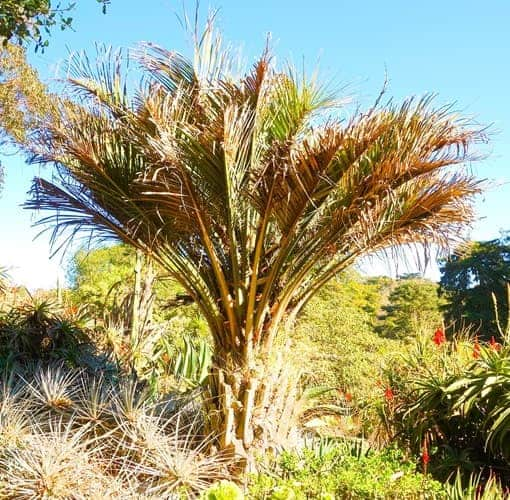 Note the trunk with remaining frond bases.
Note the trunk with remaining frond bases.Figure Out the Best Palm Trees for Florida Regions
Florida's climate creates the perfect environment for a variety of palm trees.
Visiting anywhere in the state, you'll feel the enhancing effects of their lush, tropical appeal.

Florida's seven climate zones, from 8b to 11b provide good growing conditions. For both native and non-native palms.
Different parts of Florida will be successful for growing palms which will survive the local climates. Cold spells have happened, and palm lovers should be aware of taking care of those Best Palms for Cold Weather.
- North Florida residents should look at cold-hardy palms, as the Growing Zone is primarily 9a, but a bit of 8b. Look for palms that can tolerate 15oF/-9.4oC or above.
- Central Florida has much of 9b & 10a USDA zones. Which means the lowest temps palms can endure is 25oF/-3.9oC. Get the University of FL Pamphlet to help decide.
- South Florida, as well as Florida's mid-southern Coastal areas cover zones 10b & 11. Be sure your chosen palms can bear the thermometer showing 35oF/1.7oC or above.
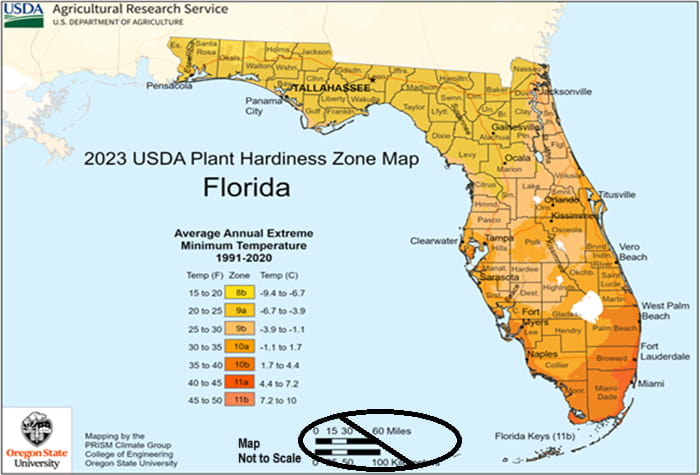
But with so many suitable palms to choose from, Florida is truly a palm tree paradise.
Miami Had Problems With Palms
In 2007 Miami-Dade County, Florida, released a master plan for urban forestry. Listing "Approved Trees."
Those visiting Miami expect palms all around. Along streets, on private properties, in parks and on beaches. One place anyone won't find all the palms we've listed here - is on the City's list of approved trees.
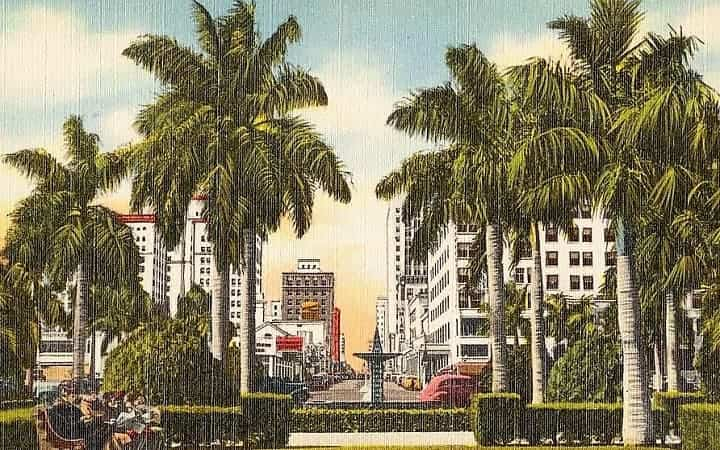 Vintage look at palm-treed Bayfront Park, that begins Flagler Street in Miami, FL
Vintage look at palm-treed Bayfront Park, that begins Flagler Street in Miami, FLThey appeared to anticipate complaints or questions. They put out a bulletin:
"While palms are aesthetically pleasing and look ‘tropical,’ they do not provide the same environmental benefits, walkable streets, or lower ambient temperatures as hardwood shade trees."
But Miami appears to have some second thoughts about their stance.
Here's the 2024 Word on Their Update
Here's the 2025 Word on Their Update
Los Angeles also had this dilemma. They admitted palms are "aesthetically nice." Yet feeling palms don't create healthier people environments.
Can We Agree AND Disagree?
We relate to their points.
We understand needing good shade. Some studies show "shady" palms have an inverse relationship to their water need, compared to popular "shade trees." Which on average use less water, while cooling their immediate area by 3-7oF.
Cities tend to be "Heat Islands." Is that the palms' fault?
No: Because cities are built with lots of ground-covering concrete, blacktop & macadam. Buildings are closely set, not leaving much room for cooling green!
 Tucson Arizona, where we live, has many areas that can be made more "green."
Tucson Arizona, where we live, has many areas that can be made more "green."Phoenix is larger than Tucson & an even worse Heat Island.
How about more green! Get creative with land donation incentives, using infrastructure funding, applying for grants, etc. To tamp down cities' unnatural heating.
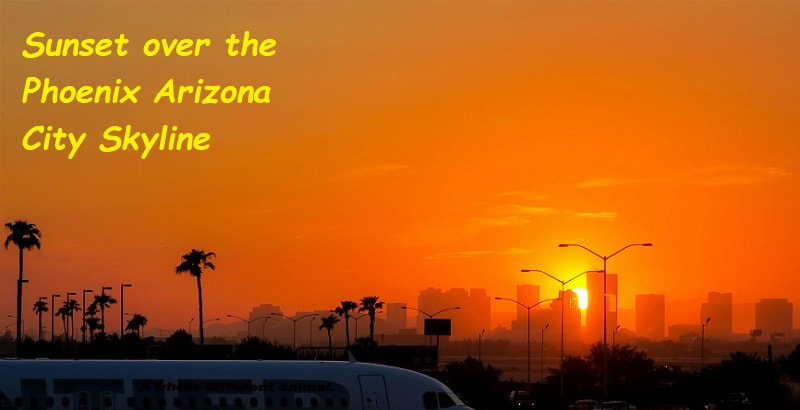 Phoenix - Setting Heat Records! More Lately Than in the Past
Phoenix - Setting Heat Records! More Lately Than in the PastOne Solution: Consider the Palm Landscaping
In cities, people use palms in their private Landscapes Designs.
Now it's even more important to design with appropriate water use & shade provision. We'll quote a rare plant nursery owner - it's quite applicable.
Flora Grubb says
"...I adore palm trees. When used correctly, when designed into a garden with skill, palms do their jobs so well."
We love palms, and agree with using them skillfully & appropriately. To avoid palms being part of the heating-up problem.
Like any plant, palm fronds use carbon dioxide and make oxygen, helping air quality. And not all palms guzzle water.
Your best selections in Florida are medium-height palm trees, with dense, wide crowns. Like the Foxtail Palm, Chinese Fan Palm, King Palm & the Bismarck Palm.
See More About Palm Trees vs. The Environment>
Kinds of Palm Trees Florida FAQs
Are palm trees native to Florida?
Are palm trees native to Florida?
Yes, but maybe not as many as you'd think. According to Florida Department of Agriculture and Consumer Services, 12 species of palms are native to Florida. Some are endangered. Click to See Which Palms are Native.
Do palm trees provide shade?
Do palm trees provide shade?
They can, but it depends on the species. Palm trees do have a bad rap for not giving enough shade. In fact some large cities have promoting getting rid of palms.
Which palms are most cold-hardy in Florida?
Which palms are most cold-hardy in Florida?
See several kinds of palm trees Florida considers cold-hardy. But which is most suitable for you? Here are those that can take limited frosty conditions in the Sunshine State:
- Rhapidophyllum hystrix, The Needle Palm (aka Vegetable Porcupine) is pointed out by palm scientists as likely the most cold-hardy palm of all.
- Sabal minor, the Dwarf Palmetto or Bush Palmetto. This native palm tolerates temporary temps as low as -15oF/-17.8oC.
- Sabal palmetto, the Cabbage Palm or Palmetto can tolerate temperatures down to 5oF/-15oC for a short time.
- Serenoa repens, nicknamed Silver Palmetto or Silver Saw Palmetto. It's not afraid of short cold-snaps.
Takeaways for Palm Trees in Florida
Both native and non-native palms can thrive in Florida, but location within the state matters. South Florida supports a wider variety of tropical palms, while Central and North Florida require more cold-hardy species.
When selecting palms, consider factors like growth size, Water Fundamentals, growth size, cold tolerance and Maintenance Essentials.
Whether native or non-native, palms are the ultimate Florida identity.
REFERENCES
USDA Plant Hardiness Zone Map
ccmedia.fdacs.gov
sfyl.ifas.ufl.edu/
Riffle, R.L. (2008) Timber Press Pocket Guide to Palms
Palmpedia, palmpedia.net/wiki/index.html
Meerow, A.W. (2002). Betrock's Guide to Landscape Palms




